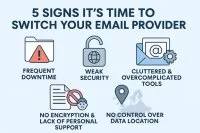PGP Encryption Email
There are endless things that we need to understand in terms of technical factors when it comes to the way that email encryption works.Most people are not really interested in being so invested in the subject, but it is good to learn the basics in order to understand the outer layers of such a complex topic.
The goal with this post is to make this as easy to grasp as possible. Once you have an idea of how this works, you will be able to consider why it is so useful to make use of it for your email strategies.
What is PGP Encryption Email?
For the 101 on PGP Encryption Email, this was founded on the PGP encryption protocol conceived by Phil Zimmermann in 1991. It represents a sophisticated cryptographic technique aimed at securing email communication. Employing a combination of asymmetric and symmetric encryption, PGP ensures that only the intended recipient can decipher the content of the email, rendering it unreadable to unauthorized parties.
Benefits of Using PGP Encryption Email
- a. End-to-End Encryption: Intermediaries, including email service providers, cannot access the content during transmission and storage.
- b. Data Integrity: PGP incorporates digital signatures to verify the authenticity and integrity of the email's content. This mechanism detects any tampering with the message during transit.
- c. Protection against Eavesdropping: The encryption process converts the email's content into ciphertext, ensuring that eavesdroppers or interceptors cannot decipher the message's actual content.
d. Decentralized Trust Model: PGP employs a web of trust model, granting users the ability to validate the authenticity of public keys without relying on centralized authorities. This system enhances security and provides more control to users.
How to Encrypt Email with PGP
- a. You need to generate a unique public key for encryption and a private key for decryption. Safeguarding the private key is paramount, as its compromise could lead to unauthorized access.
- b. Users must exchange their public keys with intended recipients. This crucial step ensures that only the intended recipient possesses the means to decrypt and read the email.
- c. While composing an email, users employ the recipient's public key to encrypt the message. Fortunately, many email clients and PGP encryption tools streamline this process for convenience.
- d. The recipient, in possession of their private key, decrypts the email to access its contents.
Setting Up PGP Encryption Email
- a. Select a Suitable PGP Tool: Choose a PGP encryption tool that aligns with your requirements and platform. Popular options include GnuPG, Symantec Encryption Desktop, and Mailvelope.
- b. Generate Your PGP Key Pair: The selected encryption tool will guide you through creating your unique key pair. Storing the private key securely is essential for maintaining the integrity of your encryption.
- c. Integration with Your Email Client: Install and integrate the PGP encryption tool into your email client to facilitate seamless encryption and decryption of emails.
Common Questions About PGP Encryption Email
- a. Is PGP encryption email entirely impervious to attacks? While PGP encryption is highly secure, its effectiveness is contingent on the strength of the private key and passphrase.
- b. What if I lose my PGP private key? Losing the private key could lead to permanent loss of access to encrypted emails.
- c. Is PGP encryption email available on mobile devices? Yes, several PGP encryption tools offer mobile versions compatible with smartphones and tablets, enabling secure email communication on the go.
Security and Privacy of PGP Encryption Email
Although PGP encryption email provides formidable security, it is vital to complement it with other security practices, such as maintaining up-to-date software, employing firewalls, and practicing caution against phishing attempts and malware.
Comparing PGP Encryption Email to Other Encryption Systems
While PGP encryption email stands as one of the most reputable encryption systems, alternative approaches like S/MIME and end-to-end encrypted messaging apps offer different features and capabilities. Selecting the most suitable encryption system depends on individual requirements and preferences.
How to Generate a PGP Key
PGP encryption tools offer comprehensive guidelines to facilitate the secure generation of these keys. This depends on several relevant factors for each tool.
Understanding PGP Encryption Email Encoding
It’s important to understand that PGP encryption email adopts ASCII-armored encoding to represent binary data (the encrypted message) as printable ASCII characters. This encoding ensures seamless transmission of the encrypted content through email systems.
Best Practices for Using PGP Encryption Email
- a. Keep PGP Software Updated: Regularly updating the PGP encryption software ensures access to the latest security enhancements and fixes.
- b. Verify Public Keys: Always verify the authenticity of recipients' public keys to prevent encryption with compromised or erroneous keys.
- c. Safeguard Private Keys: Protecting the private key with a strong passphrase and storing it in secure locations mitigates potential risks associated with unauthorized access.
- d. Foster a Web of Trust: Embrace the web of trust model to verify the authenticity of other users' public keys, enhancing the overall security of communications.
Conclusion
With a commitment to secure practices and vigilant risk management, PGP encryption email empowers users to communicate confidently, knowing that their messages remain shielded from unauthorized access in an interconnected digital landscape.

![]() © 2022 - 2025 HostingBe.com Simple CMS versie 3.1.0
© 2022 - 2025 HostingBe.com Simple CMS versie 3.1.0